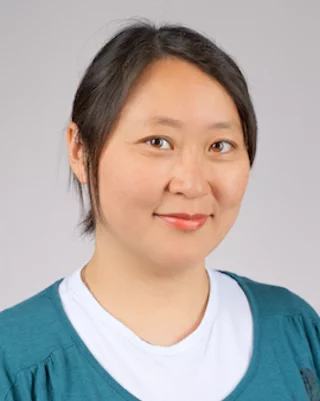Research highlight
Research interests
G-protein coupled receptors (GPCRs) are the targets of almost half of today’s pharmaceuticals. They contribute to signal transduction across the cell membrane. GPCRs are activated by extracellular stimuli such as light, hormone, and small ligand, resulting in conformational changes and interaction with a number of signalling and regulatory proteins including G proteins, kinases and arrestins. The first step in GPCR activation leads to conformational changes which trigger interaction with G proteins. There are four main subtypes of G proteins, each inducing specific signalling pathways. Most GPCRs can couple to more than one G-protein subtype, and therefore it is fundamental to understand GPCR signalling by studying the coupling specificity between G protein and GPCRs. We aim to decipher the mechanism by which this selectivity is achieved. To do so, we use X-ray crystallography, electron cryo-microscopy (cryo-EM) together with biochemical techniques to characterize the molecular mechanism of GPCR signalling complexes.
Publications
2024
- Active state structures of a bistable visual opsin bound to G proteinsNature communications, 15(1 ), 8928 (2024) doi:10.1038/s41467-024-53208-2
- Activating an invertebrate bistable opsin with the all-trans 6.11 retinal analog Rodrigues MJ, Tejero O, Mühle J, Pamula F, Das I, Tsai CJ, Terakita A, Sheves M, Schertler GFXiScience, 26(2), 105928 (2023) Proc Natl Acad Sci U S A, 121(31):e2406814121 (2024)
2023
- Ultrafast structural changes direct the first molecular events of visionNature, 615(7954), 939–944 (2023)
- Continuous population-level monitoring of SARS-CoV-2 seroprevalence in a large European metropolitan regioniScience, 26(2), 105928 (2023)
2022
- Preparation of a stable CCL5·CCR5·Gi signaling complex for Cryo-EM analysisMethods in cell biology, 169, 115–141 (2022)
2021
- Versatile microporous polymer-based supports for serial macromolecular crystallographyProceedings of the National Academy of Sciences of the United States of America, 118(31), e2024146118 (2021)
- High-mass MALDI-MS unravels ligand-mediated G protein-coupling selectivity to GPCRsProceedings of the National Academy of Sciences of the United States of America, 118(31), e2024146118 (2021)
- Structural basis of the activation of the CC chemokine receptor 5 by a chemokine agonistScience advances, 7(25), eabg8685 (2021)
- Biochemical Characterization of GPCR-G Protein Complex FormationMethods in molecular biology (Clifton, N.J.), 2302, 37–48 (2021)
2020
- GPCR Activation States Induced by Nanobodies and Mini-G Proteins Compared by NMR SpectroscopyMolecules (Basel, Switzerland), 25(24), 5984 (2020)
- Strategic Screening and Characterization of the Visual GPCR-mini-G Protein Signaling Complex for Successful CrystallizationJournal of visualized experiments, 157, 10.3791/60747 (2020)DOI: 10.3791/60747
- Membrane Protein CrystallizationStructural Biology in Drug Discovery: Methods, Techniques, and Practices: 187-210 (2020)
2019
- Emerging Two-Dimensional Crystallization of Cucurbit[8]uril Complexes: From Supramolecular Polymers to NanofibersJournal of the American Chemical Society, 141(36), 14021–14025 (2019)DOI: 10.1021/jacs.9b07506
- Cryo-EM structure of the rhodopsin-Gαi-βγ complex reveals binding of the rhodopsin C-terminal tail to the Gβ subuniteLife, 8, e46041 (2019)DOI: 10.7554/eLife.46041
- Structure-factor amplitude reconstruction from serial femtosecond crystallography of two-dimensional membrane-protein crystalsIUCrJ, 6(Pt 1), 34–45 (2019)
2018
- Crystal structure of rhodopsin in complex with a mini-G o sheds light on the principles of G protein selectivityScience advances, 4(9), eaat7052 (2018).
- Resolution extension by image summing in serial femtosecond crystallography of two-dimensional membrane-protein crystalsIUCrJ, 5(Pt 1), 103–117 (2018).
2017
- Structural biology: Signalling under the microscopeNature, 546(7656), 36–37 (2017).DOI: 10.1038/nature22491
2016
- Backbone NMR reveals allosteric signal transduction networks in the beta1-adrenergic receptorNature, 530(7589), 237–241 (2016).DOI: 10.1038/nature16577
Pre-2015
- Low-Z polymer sample supports for fixed-target serial femtosecond X-ray crystallographyJournal of Applied Crystallography, 48(4), 1072-1079 (2015).
- Time-resolved structural studies with serial crystallography: A new light on retinal proteinsStructural dynamics (Melville, N.Y.), 2(4), 041718 (2015).DOI: 10.1063/1.4922774
- 7 Å resolution in protein two-dimensional-crystal X-ray diffraction at Linac Coherent Light SourcePhilosophical transactions of the Royal Society of London. Series B, Biological sciences, 369(1647), 20130500 (2014).
- Femtosecond X-ray diffraction from two-dimensional protein crystalsIUCrJ, 1(Pt 2), 95–100 (2014).
- Structural interactions between inhibitor and substrate docking sites give insight into mechanisms of human PS1 complexesStructure (London, England : 1993), 22(1), 125–135 (2013).
- Two alternative conformations of a voltage-gated sodium channelJournal of molecular biology, 425(22), 4074–4088 (2013).
- Structure of β-adrenergic receptorsMethods in enzymology, 520, 117–151 (2013).
- Structural asymmetry in a trimeric Na+/betaine symporter, BetP, from Corynebacterium glutamicumJournal of molecular biology, 407(3), 368–381 (2011).
- Coupling electron cryomicroscopy and X-ray crystallography to understand secondary active transportJournal of molecular biology, 425(22), 4074–4088 (2010).
- The role of lipids and salts in two-dimensional crystallization of the glycine-betaine transporter BetP from Corynebacterium glutamicumJournal of structural biology, 160(3), 275–286 (2007).
- Structure determination of secondary transport proteins by electron crystallography: two-dimensional crystallization of the betaine uptake system BetPJournal of molecular microbiology and biotechnology, 10(2-4), 197–207 (2005).DOI: 10.1159/000091565
Other research activity
Invited Talks
Dec. 25, 2018, Dept of Life Science, National Tsing Hua University, Hsinchu, Taiwan
Jun 03, 2013, MRC-LMB, Cambridge, UK
Mar 28, 2013, Dept of Life Science, National Tsing Hua University, Hsinchu, Taiwan
Jan 18, 2013, D-BIOL, ETH Zürich, Zürich, Switzerland
Nov. 26, 2012, Max-Planck Institute of Biophysics, Frankfurt, Germany


